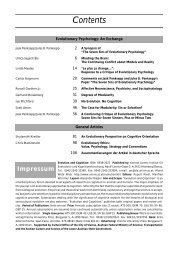Contents - Konrad Lorenz Institute
Contents - Konrad Lorenz Institute
Contents - Konrad Lorenz Institute
Create successful ePaper yourself
Turn your PDF publications into a flip-book with our unique Google optimized e-Paper software.
Was the First Craniate on the Road to Cognition<br />
looked convincing, since it lacked many of the<br />
chordate features claimed by the more recent finds.<br />
Thus the significance of the discovery of Haikouella—displayed<br />
in over 300 specimens. In CHEN’s<br />
description of Haikouella fossils, he pointed out features<br />
that not only demonstrate its chordate status,<br />
but that shed light on the origin of craniates (biology’s<br />
new name for vertebrates) (CHEN/HUANG/LI<br />
1999b). The new nomenclature reflects a new primary<br />
diagnostic feature for this taxon: a distinct<br />
head enclosing a brain and sensory organs, recognizing<br />
that this character should now take precedence<br />
over the presence of a vertebral column.<br />
Known for his research on amphioxus, the<br />
present-day animal thought to best represent the<br />
ancestor of all vertebrates, Nicholas HOLLAND said:<br />
“There’s no question these things are chordates”<br />
(ENSERINK 1999). He remarked on the great number<br />
of specimens with conspicuous gill slits (for straining<br />
food out of the water) and other diagnostic characters:<br />
“The muscle segments are unarguable, and<br />
the notochord’s good too” (HOLLAND 1999). Unlike<br />
specimens from other recent finds, both Haikouella<br />
and Yunnanozoon exhibit large notochords that<br />
clearly run the full length of their bodies. “It’s the<br />
earliest known chordate ancestor”, said HOLLAND.<br />
“Every zoology student and every paleontology student<br />
for many, many generations is going to have to<br />
look at that picture. This is going to be page one,<br />
two, three and four of vertebrate texts, and paleontology<br />
texts, and invertebrate zoology texts” (HOL-<br />
LAND personal communication).<br />
Since the discovery of Haikouella, Degan SHU et al.<br />
(1999) reported their discovery of two new chordates,<br />
Myllokunmingia and Haikouichthys, each based<br />
on a single specimen. Collaborator Simon CONWAY<br />
MORRIS proposes that the animals had skulls made<br />
of cartilage (MONASTERSKY 1999). CHEN notes that<br />
the specimens display two important features: distinctive<br />
fins (large dorsal and possibly paired ventral<br />
fins) and zigzag-shaped segmented muscles, similar<br />
to the pattern in modern fish (CHEN, personal communication).<br />
Though paleontologists of these various<br />
discoveries continue to contend with one another<br />
over whose specimens are ancestral to<br />
whose—and whose are true chordates—all agree<br />
that chordates have now been found in the early<br />
Cambrian (ENSERINK 1999; DZIK 1995).<br />
What will happen to GOULD’s Pikaia, the animal<br />
zoology textbooks presently tout as our earliest<br />
chordate ancestor HOLLAND contends that the textbook<br />
writers had no business picking up Pikaia as a<br />
chordate ancestor from GOULD’s popular book,<br />
since GOULD was not an authority on the animal<br />
(HOLLAND personal communication). GOULD had<br />
simply made it fit what he needed to relate the Burgess<br />
Shale fauna to humans. “Why do humans exist”<br />
asked GOULD on the last page of Wonderful Life.<br />
“A major part of the answer, touching those aspects<br />
of the issue that science can treat at all, must be: because<br />
Pikaia survived the Burgess decimation”<br />
(GOULD 1989, p323). GOULD had used Pikaia to relate<br />
Pikaia to us and us to his overriding theme: contingency.<br />
“What this conference has done”, said<br />
HOLLAND at the symposium where Haikouella was<br />
announced, “is to pull the rug out from under Pikaia,<br />
for sure. Nobody will ever talk about it again”<br />
(HOLLAND personal communication).<br />
Shedding Light on Vertebrate Origins<br />
Now that lower Cambrian chordates have been confirmed,<br />
zoologists must deal with the fact that Haikouella—and<br />
other early Cambrian chordates—look<br />
nothing like what they expected to see in a predecessor<br />
of Pikaia. Rather than finding evidence that<br />
this complex animal had less sophisticated ancestors,<br />
CHEN and SHU instead found examples of more<br />
complex, fully formed chordates—fifteen million<br />
years earlier. None of these newly discovered chordates<br />
have vertebrae or endoskeletons, so strictly<br />
speaking, they aren’t vertebrates. But displaying relatively<br />
large brains, these animals appear to be in<br />
the line to vertebrates, so that at the conference<br />
where Haikouella was announced, the strange term<br />
“pre-backbone vertebrate” was frequently bandied<br />
about. The brain’s early appearance would seem to<br />
demonstrate that brain and endoskeleton did not<br />
evolve together, as had been assumed, but rather<br />
that the brain appeared long before the development<br />
of the vertebrate spine.<br />
“The discovery of the first craniate shows that the<br />
evolutionary history toward vertebrates had been<br />
on track long before the origins of the backbone”,<br />
says Taiwanese biologist Chia-Wei LI ( 1999), co-author<br />
of the Haikouella description. Haikouella findings<br />
run counter to the commonly-held notion that<br />
the head could not become the dominant body<br />
structure until the body’s superstructure was also in<br />
place. It now appears that, against externalist expectations,<br />
cephalization (when the head became the<br />
dominant or controlling body structure) preceded<br />
endoskeletization (the development of an internal<br />
support structure).<br />
CHEN also identified other important features in<br />
Haikouella that preceded the development of a bony<br />
Evolution and Cognition ❘ 145 ❘ 2003, Vol. 9, No. 2








